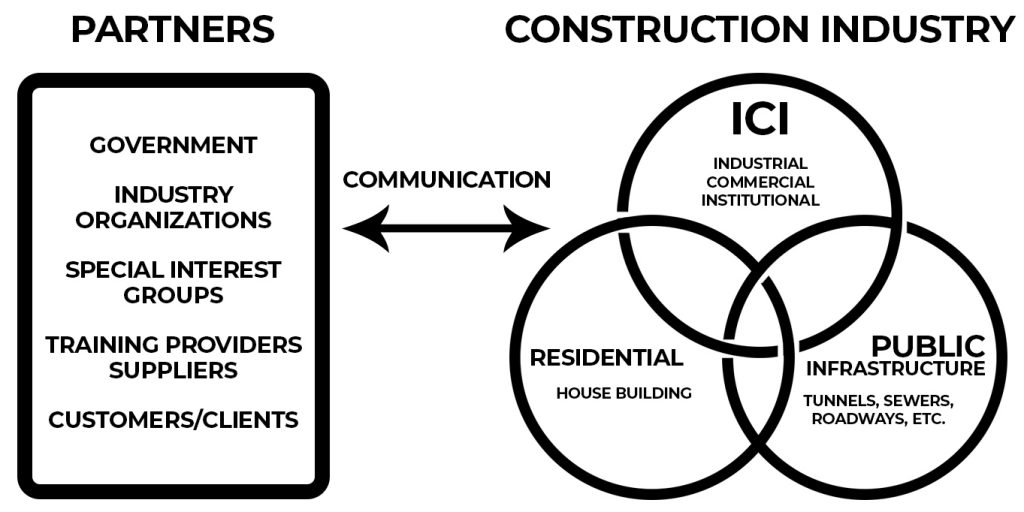State of the Sector
The construction industry in Nova Scotia is delineated into three main areas of construction activity: ICI, residential, and public infrastructure (which includes roadbuilding). Various groups of partners also exert considerable influence on the overall "health" of the sector through direct and indirect actions. The diagram below reflects both the make-up of the industry as well as the flow of communication between the various bodies. It can also be noted that overlaps exist between the areas of construction (for example, employers or workers that are engaged in both residential and ICI construction) and this can be perceived - depending on perspective - as a benefit and a hinderance.
The NSCSC focuses its activities on the ICI aspect of the construction industry which is defined by the Labour Relations Board of Nova Scotia as: "Any aspect of the construction industry other than pipeline construction, bridge building, road building, the construction of sewers, tunnels, and water mains, and house building."
House building or residential construction is defined as: "Construction of single family dwellings or duplexes for the purpose of residential use."

The Nova Scotian industrial-commercial-institutional (ICI) construction sector offers a variety of opportunities for those interested in pursuing a rewarding career in skilled trades, management, logistical, or technical occupations.
Evaluating your personal interests and aptitudes is one of the first critical steps in determining what career might be best for you.
When looking at career options, gather information that helps you to understand:
- what the occupation requires (i.e., tasks performed, skills needed, working conditions, physical requirements, etc.)
- training options & pathways
- employment outlook
- potential career advancement & transferable skills
estimated ICI workforce (NS)
14452
average age of worker
40 Years
journeypersons: 44 Years (male: 97%, female: 3%)
apprentices: 31 Years (male: 94%, female: 6%)
55%
would recommend a career in trades to their children
82%
of workers have the equivalent or more than a post-secondary certificate/diploma from a trade school/community college/technical college
56.5%
of the time, tradespeople worked within their local areas (within 100km)
Construction work is team work.
Where do I fit in?
Construction work is a cyclical process that requires a variety of workers to make a project come to life. While some workers may go to the same place everyday to perform their job, others may travel from project to project. Knowing how you like to work is an important consideration in your career search. Below are examples of different types of workers involved in the building process.
DESIGN
architect • cad • technologist • document controller • interior designer • team lead • architectural technologist • estimator • project coordinator • executive assistant • design engineer • structural cad drafter

BUILD
foreman • civil engineer • payroll coordinator • operating engineer • shop foreman • safety officer • bricklayer • surveyor • insulator • construction supervisor • carpenter • welder • ironworker • project manager • boilermaker • sheet metal worker
MAINTAIN
HVAC technician • building systems coordinator • mechanical maintenance planner • hazardous materials specialist • electrician • sustainability consultant • building services engineer • leed coordinator • remediation specialist • roofer
NOVA SCOTIA CONSTRUCTION SECTOR COUNCIL (ICI) INDUSTRY DATA
The Nova Scotia Construction Sector Council (NSCSC), As a member of the Association of Industry Sector Councils (AISC), conducted a 14-sector analysis of Nova Scotia’s Workforce. The industry data gathered (from December 2021 to March 2022) specific to the ICI Construction Sector focuses on understanding the challenges an employer/organization are currently experiencing related to the Demand and Supply of the Labour force and how several factors such as recruitment, retention of employees along with retirement, COVID-19, diversity, and inclusion, etc are affecting the employers as well as the labour force.
The population of Nova Scotia surpassed 1 million in 2022. The ICI Construction sector accounts for 8-10% of the total GDP and employs 16,674 employees with approximately 14,100 in trades-related occupations and balance in management, administration and supporting roles. We received 78 responses from employers in the ICI sector. 90% of respondents were management, with remaining respondents including but are not limited to, HR, accountant, and other administrative roles.
*Hovering the cursor over graphs provides further information.
*The dashboard is viewed best on a desktop.
